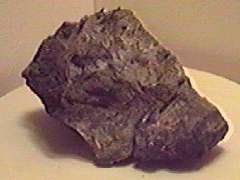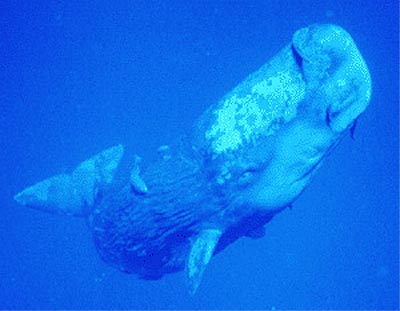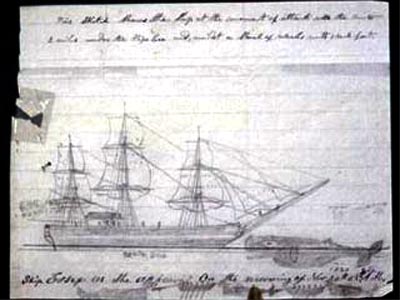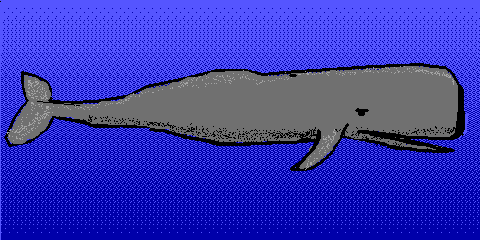The Sperm Whale
|

His
legs trapped in the whale's mouth, Nye felt himself dragged
under the sea .  (Copyright
Lee Krystek 1998) (Copyright
Lee Krystek 1998)
|
March 1863: The long boat approached the sperm
whale slowly. On board Peleg Nye, of Cape Cod, readied his bomb
lance harpoon. Taking careful aim, he fired at the massive creature's
blue-black skin. The animal struggled, then stopped. Thinking
the whale was dead ,the crew of the boat pulled along side.
Nye poked the creature with a hand lance.
Suddenly the creature slapped its gigantic
tail and turned, grabbing the boat in its jaws. Nye fell forward
into the sperm whale's mouth. In horror he felt his legs, just
below the knees, clamped tight as if in a vice. His legs were
caught in the gaps between the creature's peg-like lower teeth.
Then the animal sounded, diving for the bottom of the sea and
taking the helpless sailor with it. The world got dark and Nye
lost consciousness.
On the surface, the remainder of the long boat's
crew looked for Nye. They couldn't find him. Then the black
mass of the whale rose to the surface. It was dead, finally
killed by the action of the exploding lance. Floating up with
it came Nye's body. His shipmates pulled him aboard and with
difficulty, revived him. From then on, till he died at age 79,
he was known as the "Jonah of Cape Cod."
The sperm whale, Physeter catodon, is the
largest-toothed animal alive today. Some grow as large as sixty-two
feet in length and weigh 50 tons. While larger whales, like
the Blue, may filter small animals out of the water and consume
them, the sperm whale is the largest animal that hunts and eats
using its teeth.
|

A
chunk of Ambergris found in a sperm whale's intestine.
|
Sperm whales live in the cold northern and southern
waters of the world and are believed to never venture into equatorial
seas. For that reason, the arctic and antarctic populations
don't interbreed.
For many years the sperm whale was the source
for many valuable commercial items. Spermacetirc oil, a waxy
material found in the head of the animal, was used in making
candles, cosmetic oils, and fine lubricants. Ambergris (right),
found in the whale's intestine, was valued as a stabilizer in
perfumes. Blubber, the fatty substance that insulates all whales
from cold water, was an important source of oil.
Hunting sperm whales was a dangerous profession
in the days before cannon-launched harpoons and motorized vessels.
A small boat was lowered from the main ship and rowed quietly
toward the whale. When close enough, a barbed harpoon was thrown
into the whale's body. Sperm whales, enraged by an attack, have
been known to turn on the boat, ram it with their heads, smash
it, spill the crew out and crush the men in their powerful jaws.
Sperm whales, like all whales, have lungs and
must come to the surface to breath (a whale spout is not water,
but an exhale of warm, moist air that condenses in the colder
sea air). They can submerge for as long as fifty minutes and
dive as deep as 3,300 feet in search of food. Scientists suspect
sperm whales hunt by using sound as a weapon. In the head of
the whale is an organ called the spermaceti. The whale can use
this as a kind of "sound lens" in order to focus an intense
beam of sound energy on a specific target (like a squid, or
a fish). The explosive "crack" sound is enough to stun or kill
the animal. The sperm whale will then slurp the prey down whole
and, in some cases, still alive.
|

A
young sperm whale. (NOAA)
|
The sperm whale is believed to have only one natural
enemy: the giant squid. It is questionable,
though, if even the largest squid would risk attacking an adult
sperm whale. Giant squid and sperm whales have been observed
in mortal combat, but it is difficult to say who was the original
aggressor. Typically the squid will try to strangle the whale
with its tentacles as the whale tries to eat the squid whole.
Sperm whales were almost hunted to extinction
by man, but a ban on whaling has allowed the animals to at least
partly recover their numbers.
Man hasn't always gotten the best of the sperm
whales as an incident from 1820 shows:
The whaling ship Essex was in the South
Pacific on November 20th of that year. She was three months
out of Nantucket Island and the voyage had so far been very
successful. A thousand barrels of oil had been collected from
whales already and the ship was half-filled. The crew was beginning
to anticipate a quick trip home with high profits. They were
very wrong.
By eight o'clock that morning spouts had been
spotted on the horizon. The captain brought the Essex,
a 238-ton ship to a stop and 18 of the crew took to three long
boats to start the attack. The steward and cabin boy were left
on board. The captain, George Pollard, took charge of one boat;
the first mate, Owen Chase, took charge of the second; and the
second mate, Matthew Joy, handled the final boat.
|

A
sketch of the Essex and the whalemade in 1820.
|
Each boat rowed toward the school of sperm whales
and picked out a target. Chase's boat attacked first. The boat
carefully came in beside the prey. After the harpoon was thrown,
the boat was turned quickly away to try and avoid the thrashing
tail of the injured creature.
The whale unexpectedly changed course and its
flukes hit the boat, knocking a hole in it. The crew let the
whale go, and rowed back to the Essex to make repairs.
After hoisting the boat aboard, Chase noticed
a large sperm whale had left the school and was lying off the
bow of the ship. Chase was amazed when the animal suddenly started
swimming toward the vessel at full speed. The whale struck the
Essex with its head just behind the bow.
"The ship brought up as suddenly and violently
as if she had struck a rock and trembled for a few minutes like
a leaf," recalled Chase. "We looked at each other with perfect
amazement, deprived almost of the power of speech."
The whale had smashed through the bulkhead and
the ship was leaking badly. Chase set the crew to work on the
pumps and signaled the other boats to return immediately. The
whale, meanwhile, had moved off some distance and was apparently
badly injured. It was leaping and twisting in convulsions, beating
the water around it to foam.
Then suddenly the animal was racing toward the
ship again, its head high above the water like a battering ram.
It hit, stoving in the port side of the ship. The Essex
was doomed.
The whale disappeared, probably fatally wounded.
The crew threw all the supplies it could into the remaining
long boats and abandoned ship. A few minutes later the Essex
rolled on its side.
The other two boats had successfully killed and
secured two whales when they noticed that the ship had disappeared.
Cutting the whales free, the boats rowed back to where they'd
left the ship. The captain was speechless as Chase told him
what had happened.
The situation was desperate. They were thousands
of miles away from land in three light boats. The captain ordered
that the masts of the ship be chopped away so they could right
the vessel long enough to get some food off her. After salvaging
everything they could, the boats headed east. Several of the
crew starved during the trip. Two were left on Henderson Island,
an isolated and barren piece of land, in order to raise the
chances of the others surviving to reach civilization.
 The
boats got separated in a storm and on February 15th Chase's
group was rescued by the ship Indian of London. Captain
Pollard's boat reached the Island of Santa Maria off of Chile
on February 23rd. The third boat disappeared and was never heard
from again. A ship was sent to Henderson Island and the two
crew left there were rescued on April 5th.
The
boats got separated in a storm and on February 15th Chase's
group was rescued by the ship Indian of London. Captain
Pollard's boat reached the Island of Santa Maria off of Chile
on February 23rd. The third boat disappeared and was never heard
from again. A ship was sent to Henderson Island and the two
crew left there were rescued on April 5th.
It is assumed the surviving crewmembers had learned
a healthy respect for the power of the sperm whale.
 Do
an experiment that shows the power of sound.
Do
an experiment that shows the power of sound.

Copyright Lee
Krystek 1996,1998. All Rights Reserved.